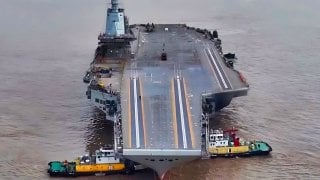China Isn't Bluffing
The Shandong's presence in the South China Sea, an area with disputed waters and rich resources, signals potential conflict. The U.S.-led coalition's readiness contrasts with China's increasingly isolated stance.
Summary and Key Points: The U.S. military, alongside 28 partner nations, has initiated the largest RIMPAC naval exercise near Hawaii, involving 40 ships, three submarines, and over 150 aircraft.
-Notably, China, which previously participated in 2014 and 2016, was not invited. In response, China deployed the Type 002 Shandong aircraft carrier near the Philippines, escalating regional tensions.
-The Shandong's presence in the South China Sea, an area with disputed waters and rich resources, signals potential conflict. The U.S.-led coalition's readiness contrasts with China's increasingly isolated stance.
China's Shandong Carrier Deploys Near Philippines Amid RIMPAC
Last week, the United States military, joined by 28 partner nations, kicked off the largest naval exercise near Hawaii. This year's Rim of the Pacific (RIMPAC) exercise, which will run until the beginning of August, is one like no other – featuring 40 surface ships, three submarines, and more than 150 aircraft taking part in the multi-week drills that range from natural disaster response to combat sorties.
Most of the nations are those located around the Pacific, but this year's RIMPAC includes participation from non-Pacific nations, including Brazil, France, Germany, India, Israel, and the United Kingdom. However, one Pacific nation that was not invited was the same one that the drills now seemed aimed to deter. That is notably China, which did take part in 2014 and 2016 and reportedly used its presence to gain intelligence on the U.S. and other regional nations.
As Beijing hasn't been invited to take part in this year's monumental RIMPAC, it has apparently opted to counter the exercise by deploying a carrier strike group towards one of the observer nations, namely the Philippines.
The People's Liberation Army Navy (PLAN) Type 002 Shandong was spotting sailing near Luzon Island on Saturday. Open source satellite data reported that the vessel was as close as 200 nautical miles from the Philippines, near the extent of the island nation's exclusive economic zone (EEZ). This marks the first time that the PLAN aircraft carrier has operated so closely to Filipino territory. Manila has not responded to the presence of the Chinese carrier so close to its waters.
Western Pacific Deployment Coming?
According to Chinese state media outlet the Global Times, the Type 002 Shandong is reportedly set to take part in scheduled exercises while the carrier and her escorts may be preparing for a deployment to the Western Pacific. Depending on when that transit takes part, it could see the second of China's two fully-operational aircraft carriers deploy close to the ongoing RIMPAC drills.
The Global Times cited Chinese military expert Zhang Junshe, who told the outlet it is "completely normal" for the warship to conduct training exercises in the South China Sea as it is "only through training" that the carrier is able to gain combat experience.
However, the outlet downplayed that the training is taking part in highly disputed waters, and China's exercises are likely to help give it an advantage in the waters should it come to blows with a regional rival. Tensions have escalated between Beijing and Manila, as both nations have competing claims to the waters of the South China Sea and the region's natural resources, notably the rich oil and gas reserves as well as the rich fishing waters.
It is unclear how long the Type 002 Shandong will remain in the South China Sea or if it will head towards the Pacific, but it could portent a looming conflict in the Indo-Pacific. It may be worth noting that if a war comes, the United States is part of a coalition with many now preparing in the ongoing RIMPAC exercises, while it appears Beijing may be ready to go it alone.
Author Experience and Expertise: Peter Suciu
Peter Suciu is a Michigan-based writer. He has contributed to more than four dozen magazines, newspapers, and websites with over 3,200 published pieces over a twenty-year career in journalism. He regularly writes about military hardware, firearms history, cybersecurity, politics, and international affairs. Peter is also a Contributing Writer for Forbes and Clearance Jobs. You can follow him on Twitter: @PeterSuciu. You can email the author: [email protected].


